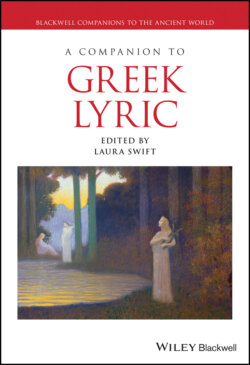Читать книгу A Companion to Greek Lyric - Группа авторов - Страница 43
Victory Memorials
ОглавлениеPindar’s odes belonged to a group of lyric productions now known as epinician or victory odes. The basic ideological maneuver of these poems is to liken the achievement of the victor to the achievements of past heroes by linking a mythical narrative to the present context through proverbs, or gnomes, and verbal and thematic echoes. The poems were typically commissioned by the victor or a family member for performance by a chorus on his return from the games. This combination of choral performance and praise of the individual represented a radical hybridization of earlier practice, relocating the praise of the individual from the private symposium into a communal space, and applying the “choral form to the praise of a single mortal individual.”4 The precise venues for performance depended on the norms of the local community, as well as the patron’s influence, but existing local cults were likely often appropriated as venues for performance, by aristocrats as well as tyrants.5 Such takeovers of existing civic institutions would have embedded the praise of the victor and his family more directly in the fabric of the local community.
The form flourished in the hands of three great practitioners, Pindar, Bacchylides, and Simonides, but they were not the only producers; papyrus finds have revealed at least epinician-like lyric poems from before Simonides,6 while an ode by an unknown poet from the mid-fifth century is preserved in the manuscript tradition as Pindar’s Olympian 5.7
The rough date of the odes as a whole is secure, but precision for individual odes can be elusive. Precise dates for the odes rely for the most part on precise dates for the victories, and these dates rely in turn on victor lists, whether these lists themselves survive (as, for example, the Oxyrhynchus victor list, whose fragments cover two sequences of victors from the time of epinician) or are reflected in the information provided by the scholia to Pindar odes. These victor lists have limitations, however: they do not cover all events; they cover only Olympic and Pythian victories; and they contain errors and contradictory information.8 Moreover, some odes were commissioned well after the victory given the primary billing, so that the victory date represents only a terminus post quem for the ode itself. Some celebrated a career that was coming to a close,9 while others celebrated a later installation into a civic office. These odes demonstrate epinician’s flexibility. They are certainly epinicians—athletic victories are praised—but the athletic achievements are themselves deployed in support of new civic achievements.10
There were options other than epinician for commemorating an athletic victory. Statues and other kinds of dedication, set up at the sanctuary where the victory was won, or in a sanctuary or public place in or near the victor’s hometown, could serve the same purpose. A cheaper alternative was provided by specially commissioned vases; one vase records the victory of a Dysniketos in a horse race.11 Tyrants had the option of commemorating victories on their coins: Anaxilas, tyrant of Messene and Rhegium, minted a distinctive and voluminous series of coins featuring a mule cart that commemorated a victory in that event.12 Finally, a particularly impressive victor in a gymnastic (that is, non-equestrian) athletic event could try to pursue a place in an orally transmitted legend that cast him as a hero, whether by imitating the actions of Heracles in deeds of war, feats of strength or even death, or by inserting himself into a pre-existing cult and displacing the cult’s previous occupant. This latter was done by Euthymus of Epizephyrian Locri, three-time winner of the Olympic boxing, in 484, 480, and 472. He was said to have driven away a vampiric spirit from Temesa, in the hinterlands of Locri.13
The development of epinician in the latter half of the sixth century, and the elaboration or invention of these other vehicles for commemorating athletics—including the use of (increasingly lifelike) statues that purported to represent the athletes as dedications14—should be understood as part of a concerted effort on the part of the elites, both the traditional elites and those more newly risen to prominence, to establish the value of athletic competition. Epinician became a significant kind of lyric production precisely because the value of athletics was disputed, and should be understood as a response both to the specific criticisms that were or could be voiced about athletics and to challenges to aristocratic power more generally.
